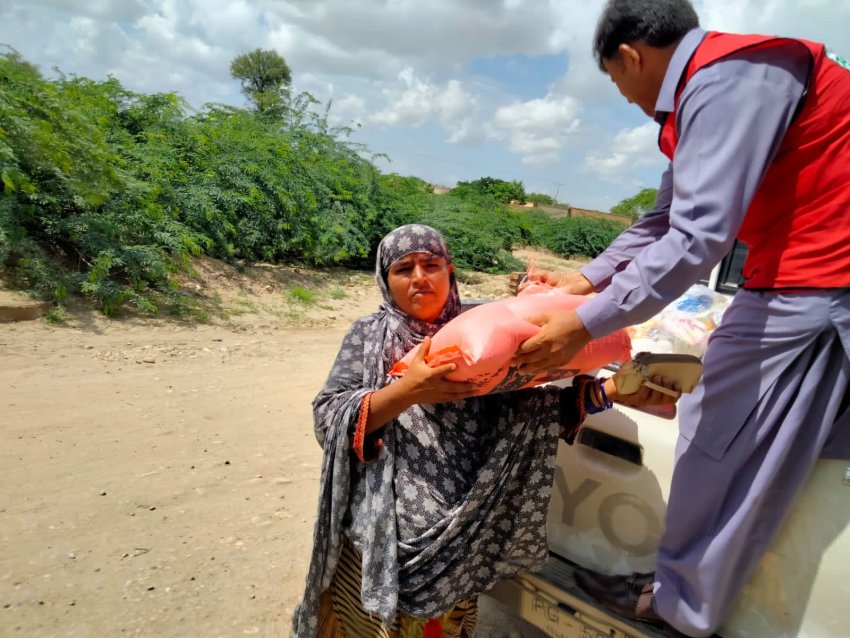
Incessant monsoon rains and flash floods have devastated Pakistan, affecting millions of people and incurring huge economic losses.
According to official figures from the National Disaster Management Authority, the floods have so far claimed the lives of 1350 people. One million houses are totally or partially damaged, leaving behind millions in need of urgent shelter. More than 50 million people have been displaced from their homes.
According to Sindh provincial government, more than 10 million people are homeless in Sindh province alone.
Livelihoods are also being heavily impacted. More than 1 million livestock — a critical source of sustenance and livelihood for many families — have died, of which 63% are in Balochistan and 25% in Punjab.
About 1.6 million hectares of crops and orchards have also been impacted, including at least 123,000 hectares in Balochistan, 177,000 hectares in Punjab, 14,400 hectares in Khyber Pakhtunkhwa (KPK) and 1.1 million hectares in Sindh.
Damage to infrastructure has further worsened the humanitarian situation. More than 3000 kilometres of roads and 220 plus bridges are partially or completely destroyed. This impedes the ability of people to flee to safer areas and travel to access markets, healthcare, or other vital services, and restricts the delivery of aid to people in need.
More than 1000 health facilities are either partially or fully damaged in Sindh province and 198 health facilities are damaged in affected districts in Balochistan.
The damage to roads and bridges has also compromised girls' and women's access to health facilities. Provisional data from provincial Education Departments shows that at least 17,566 schools have been damaged or destroyed due to the emergency: 15,842 schools in Sindh, 544 in Balochistan and 1180 in Punjab.
Pakistan produces less than 1% of global carbon emissions and yet it is one of the countries that bear the worst consequences of the climate crisis. For the past 20 years, it has consistently ranked in the Global Climate Risk Index as among the top ten most vulnerable countries in the world. Pakistan and other South Asian countries are climate crisis hotspots.
The rice and cotton growing areas of Sindh and South Punjab are most affected by the flood. Almost half of the country's cotton crop has been washed away. Similarly, mango orchards and red chilli farms in Sindh are also under floodwater. There is an 85% loss in dates. The cotton crop in the Saraiki Waseeb area has been hit hard. The standing sugarcane crop has also suffered up to 7% damage due to floods, despite it being a high water-consuming crop, which shows the intensity of the disaster small farmers and peasant communities are facing.
In many areas of KPK, especially in the cities of Swat, Nowshera and Charsadda, maize and rice crops have been washed away due to flash flooding. Small farmers, farm workers and peasant communities have lost their lands and animals. Their houses have been swept away and they are living in the open air, without a roof or shelter.
There could be issues with the next crop sowing as well. One is land, which may take more time to dry out. Another is lack of resources facing small farmers as they usually use the proceeds from previous crops to sow the next. They have lost livestock and crops. They are displaced. They will need help from the government and others to invest in the next season’s crop.
The other issue could be demarcation of land. Due to the floods, these are required to be done again altogether.
Millions of Pakistanis affected are in desperate need of aid, as authorities say they have been “overwhelmed” by the scale of the disaster, with the country’s climate minister is calling it a “serious climate catastrophe”. To ensure the provision of relief and rehabilitation for flood affectees, the government requires more than Rs72 billion.
According to the initial tender assessment report, more than Rs7 billion is required in cash relief, while nearly Rs9 billion is needed to provide non-food items, and nearly Rs2 billion will need to be spent on medical expenses.
Saving cattle requires more than Rs9 billion, while to buy equipment to speed up the relief process will require nearly Rs5 billion to be in place. Reconstruction of infrastructure and about 82,000 homes requires Rs41 billion overall, according to Urdu Independent.
Flood afectees need following ration items immediately:
• Clean drinking water
• Dry fuel such as wood, kerosene oil etc
• Dry eatables (as cooked food might perish or be only useful one time)
• Milk powder (for children) and boxes of liquid milk
• Linen sheets instead of blankets and duvets
• Stitched clothes which can be readily worn
• Plastic shoes (as stitching of regular shoes is useless amid stagnant flood water)
• Sanitary pads (with disposing wrappers) or cloth napkins for women affectees
• Raw food items such as rice, flour, and lentils (for people stuck in homes due to flooding)
• Dry rations such as roasted black lentils and dates
• Dry fodder for cattle
• Tents
The Pakistan Kissan Rabita Committee (PKRC) and Haqooq e Khalq Party have been doing flood relief work since July 29 and are in contact with affected communities in South Punjab, Sindh and Balochistan. We are sending flood relief items and food rations to those who are in need of immediate assistance. We have also arranged medical camps with volunteer work by young doctors.
We need your immediate support, please send donations to our sister organisation Crofter Foundation’s bank account. Crofter Foundation is a registered organisation in Pakistan. Bank name: Silkbank Account Title: Crofter Foundation IBAN: PK07SAUD0000032008215629 SWIFT: SAUDPKKA Address: Silk Bank, Main branch, Egerton Road, Lahore, Pakistan
[Farooq Tariq is General Secretary of the Pakistan Kissan Rabita Committee, a network of small farmers organisations established in 2003, which is a member of La Via Campesina.]